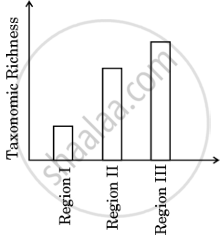Advertisements
Advertisements
प्रश्न
Read the following passage and answer the questions that follow.
|
Isn't it incredible that India’s land area is only 2.4 percent of the world’s total land area whereas its share of the global species diversity is an impressive 8.1 percent! However, in these estimates of species, prokaryotes do not figure anywhere. Biologists are always keen on collecting data with respect to species diversity observed in different regions of the world. The data collected based on the survey conducted for species richness of groups of mammals in three different regions of the world is shown in the bar graph given below:
|
(a) Why is the species richness maximum in Region III in the bar graph? (1)
OR
(a) Why is the species richness minimum in Region I in the bar graph? (1)
(b) Plants and animals do not have uniform diversity in the world but show rather uneven distribution. Mention what this kind of diversity is referred to as. (1)
(c) Why is it that prokaryotes do not have an estimated number of their species diversity as seen in plants and animals? Explain. (2)
उत्तर
(a) Region III of the bar graph has the highest taxonomical richness, indicating the presence of the most diverse species in a given location or ecological habitat.
OR
(a) Since area I of the bar graph has the lowest number of distinct species found in a region or ecological habitat, or taxonomical richness, it has the lowest species richness.
(b) This kind of diversity is referred to as species diversity.
(c) Prokaryotes do not have an estimated number of their species diversity as seen in plants and animals as:
- Studying bacterial species diversity by standard taxonomic approaches is challenging.
- They are miniature, making their estimation challenging.
- The majority of prokaryotic species cannot be cultured in vitro, rendering proper study infeasible.

